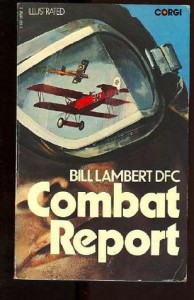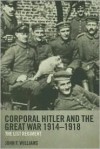Currently reading
FLYING WITH THE FALCONS IN FRANCE IN 1918

"COMBAT REPORT" is Bill Lambert's memoir detailing his combat experiences as a fighter pilot on the Western Front between March and August 1918.
Unlike many of his contemporaries, Lambert had had no inclination to write or talk with anyone about his WWI service. Several publishers in the intervening years had expressed interest in Lambert's story. But Lambert had no interest in revisiting that period of his life as a pilot in the Royal Flying Corps (RFC)/Royal Air Force (RAF). It was only at the prompting of a friend 50 years after the war (a period which experienced a major resurgence in public interest in WWI aviation) that compelled Lambert to write this book. I'm glad he did, because - aside from Arthur Stanley Gould Lee's combat memoir "No Parachute" - "COMBAT REPORT" is one of the best memoirs on WWI air combat that I've yet read.
Lambert was an American working in Canada when he joined the RFC in the spring of 1917. He received his initial flight training at a number of bases in Canada before being sent overseas to Britain in November of that year. (Aviation was something that had fascinated Lambert from the time that he saw a Wright Flyer in his State of Ohio in July 1910 at a fair. He relates to the reader his subsequent experience of meeting the pilot and later being treated to a short flight over the fairgrounds.)
While in Britain (where he received advanced flight training), Lambert became acquainted with the fighter plane he would later fly in combat, the S.E. 5A. From the moment he was given permission by the base commander one day to take the plane up for a flight, Lambert fell in love with the S.E. 5A, which boasted a Vickers machine gun synchronized to fire through the propeller arc and a Lewis machine gun, set on a slender platform near the cockpit, which could be moved up and down by the pilot from the upper wing to the cockpit for reloading or clearing a stoppage. The S.E. 5A was also very fast, rugged, highly maneuverable, noted for its climbing ability, and its speed in a dive.
By March 1918, Lambert had completed his training and was sent to France to serve with No. 24 Squadron, one of the first RFC fighter squadrons to arrive in France in early 1916. Lambert came to No. 24 Squadron at a very crucial stage of the war. The Germans had just launched the first of its major offensives (this one against the British) designed to ensure Germany victory before American forces could arrive in strength. Lambert's learning curve was steep. The squadron was short of experienced pilots and as a novice pilot, he was hard pressed to grasp all the essentials of air fighting he needed in order to survive. Thus, the first few weeks at the Front were highly stressful - learning how to sight enemy aircraft, dodging 'Archie' (i.e. German anti-aircraft fire), and engaging in hazardous low-level attacks on enemy installations and front-line trenches. As a reader, I felt I was very much a part of Lambert's life with No. 24 Squadron.
There are 2 vivid sections in the book that were both revelatory and highly fascinating to read about. The first was Lambert's description of his activities while on a 2-week leave in Britain (spent both in London and in Northern England, where he and a pilot from No. 20 Squadron stayed with a family on their extensive country estate) in late July 1918. It was the first leave that Lambert was able to get after almost 5 months at the Front. (One thing I'll save for those soldiers, sailors, and airmen who were able to get leave to go to London - they sure knew how to PARTY!!!)
The other section details one of the missions Lambert flew over the Front the following month in the wake of the Allied counter-offensive at Amiens (which eventually helped to break the back of the German Army once and for all). Here is some what Lambert relates to the reader about the mission -
"... The members of 'C' flight separate and so do the Germans. It is a question now of every man for himself. I see a D. VII, red nose, yellow-gold fuselage, light blue-green tail and top wing in that coloured lozenge design, going down on an S.E. 5. He is not far ahead of me but too far from the other S.E. to fire. Now is the time for 8395 [Lambert's plane] to do her stuff. Nose down and wing right to get behind that golden D. VII. He is leaving me. More throttle, nose down more and we close the gap. I try to fix him in my Aldis [gunsight] and push the stick farther forward. About 100 yards between us. I push the throttle full forward. We are closing; almost ready now. Another look through my sight. About 50 yards. Close enough. My thumb presses the button. Both guns fire and what they threw out was enough. The D. VII goes into the craziest manoeuvre, its nose well down with the tail waving up and down. ... he heads for the ground with tail still waving. Did my bullets cut his elevator shaft in two? We are down now to 5000 feet and have no time to watch him all the way to the ground. Another D. VII is about 200 yards behind, diving with nose alost vertically down. I throw 8395 to the right in a steep climbing turn, level out for a second then nose down for speed, back on the stick for a wide loop and half roll out. Where is that Fokker? For some unknown reason he is still going straight down and I watch him hit the ground and explode.
"The others are 3000 or 4000 feet above me and scattered all around in a terrific fight with S.E.5s, Fokkers, Albatri and Hannoveraners in one mix-up mess. Twisting, rolling, looping and side-slipping; anything to dodge those bullets. ... I climb as fast as possible. Another S.E. 5 might need help up there. Going up, I noticed that old Halberstadt waddling across the sky, seemingly trying to get out of this mess and go home. Shall I go after him or continue on up? He is not bothering anyone so I let him go in peace. ... The Germans are everywhere, in some cases, two after one S.E. 5. I see a Fokker with green nose, red fuselage back to the tail surfaces which are blue with a white rudder. A wide white strip splits the side of the fuselage. This fellow is everywhere. He pounces on the tail of an S.E. but I come in from his right side and let go with everything I have from about 50 yards. Did I hit him? Anyway, he dives off left and gives up on the S.E.
"Something hits me from the rear. I turn in my seat and are looking at the red nose of an Albatros at about 100 yards. Down goes 8395 as I ram my throttle full front preparatory to pulling up for a climbing right turn to get above and behind him. He does the same but ends up off my tail and two other S.E. 5s are after him like hawks. On the ground I see heavy black smoke from burning aeroplanes. Any any of them ours? I do not know. Action is too fast and furious to check anything. In this sort of affair, one has no time to count noses. Every man fends for himself.
"A Hannover is busy with an E.E. 5 above and to the left front of him. I push my nose up to get above and to his right as the other S.E. dives from the top left with both guns flaming. The Hannover observer and his pilot are both concentrating on that S.E. and do not see me. I must take a chance on this deflection shot so bank to the left and find him in my sight, aiming possibly five or six yards ahead of his nose. The crew are still watching the S.E. 5. My range is about 30 yards; still okay in my sight. I press the button and fire about 50 rounds from each gun. The observer jerks up in his cockpit, drops his guns and falls down out of sight. The aircraft falls to the left in a side-slip for a few hundred feet then into a spin to the ground. It hits with a terrific burst of flame and smoke. A second later I see two sets of back crosses falling through the sky with heavy smoke trailing behind. They, too, hit the ground. Someone is going a good job! Time to look around. We are still spread over the sky from 5000 feet down to 1500 feet. Plenty of S.E.s but too widespread to count. The number of Germans has diminished. ...
"... My petrol is very low. Time to go home. All the E.A. [enemy aircraft] have now gone. Hazell pulls away with me alongside, to round up the remaining S.Es. Are we all here? Within a few minutes we find out. Twelve S.E. 5s are circling in a bunch. Hazell heads northwest with the rest of us trailing behind."
Lambert pulls no punches in sharing with the reader the perils and hazards, as well as pleasure of combat flying. Yes, pleasure, for flying is a skill requiring all of one's senses. When done well, flying spells pure excitement for the pilot and a deep sense of accomplishment in mastering something that few people manage to do. It is not for the faint of heart, especially under wartime conditions.
"COMBAT REPORT" is an ideal book for anyone curious to learn about the life of one remarkable pilot amid the madness of the final months of World War I. HIGHLY RECOMMENDED.
 2
2













